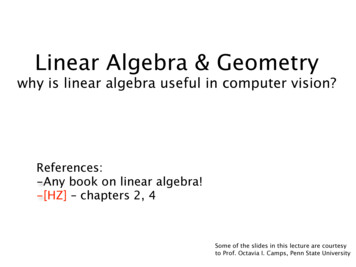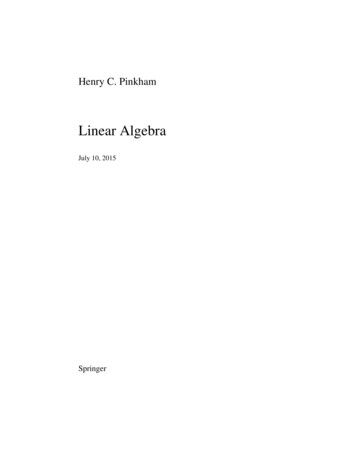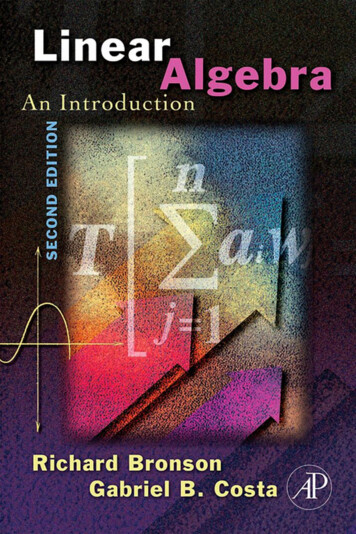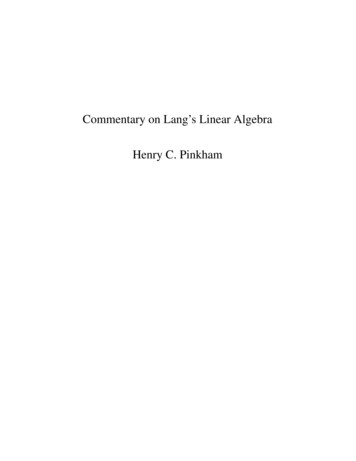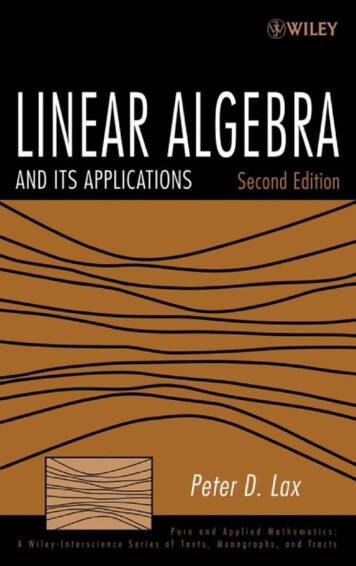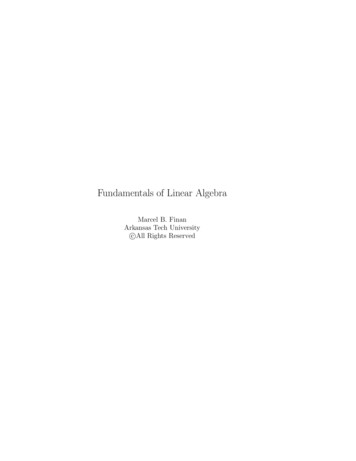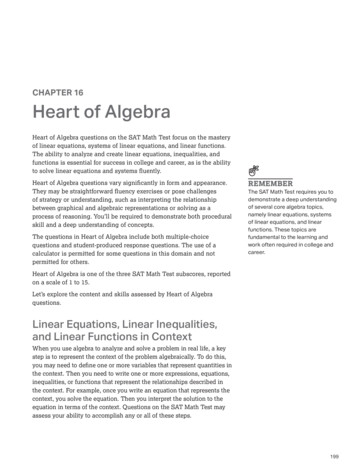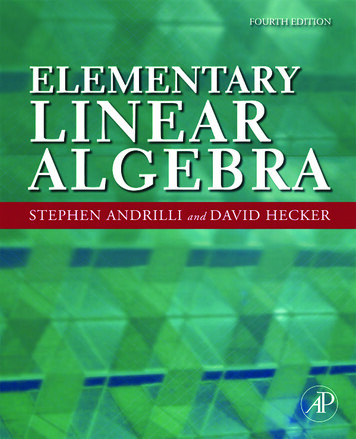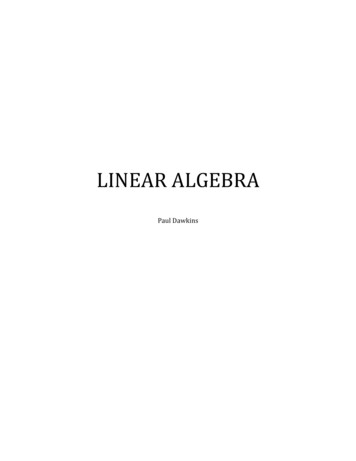
Transcription
LINEAR ALGEBRAPaul Dawkins
Linear AlgebraTable of ContentsPreface . iiOutline . iiiSystems of Equations and Matrices . 1Introduction . 1Systems of Equations . 3Solving Systems of Equations . 15Matrices. 27Matrix Arithmetic & Operations . 33Properties of Matrix Arithmetic and the Transpose . 45Inverse Matrices and Elementary Matrices . 50Finding Inverse Matrices. 59Special Matrices . 68LU-Decomposition. 75Systems Revisited . 81Determinants . 90Introduction . 90The Determinant Function . 91Properties of Determinants .100The Method of Cofactors .107Using Row Reduction To Compute Determinants .115Cramer’s Rule .122Euclidean n-Space . 125Introduction .125Vectors .126Dot Product & Cross Product .140Euclidean n-Space .154Linear Transformations .163Examples of Linear Transformations .173Vector Spaces . 181Introduction .181Vector Spaces.183Subspaces .193Span.203Linear Independence .212Basis and Dimension .223Change of Basis .239Fundamental Subspaces .252Inner Product Spaces .263Orthonormal Basis .271Least Squares .283QR-Decomposition .291Orthogonal Matrices .299Eigenvalues and Eigenvectors . 305Introduction .305Review of Determinants .306Eigenvalues and Eigenvectors.315Diagonalization .331 2007 Paul Dawkinsihttp://tutorial.math.lamar.edu/terms.aspx
Linear AlgebraPrefaceHere are my online notes for my Linear Algebra course that I teach here at Lamar University.Despite the fact that these are my “class notes” they should be accessible to anyone wanting tolearn Linear Algebra or needing a refresher.These notes do assume that the reader has a good working knowledge of basic Algebra. This setof notes is fairly self contained but there is enough Algebra type problems (arithmetic andoccasionally solving equations) that can show up that not having a good background in Algebracan cause the occasional problem.Here are a couple of warnings to my students who may be here to get a copy of what happened ona day that you missed.1. Because I wanted to make this a fairly complete set of notes for anyone wanting to learnLinear Algebra I have included some material that I do not usually have time to cover inclass and because this changes from semester to semester it is not noted here. You willneed to find one of your fellow class mates to see if there is something in these notes thatwasn’t covered in class.2. In general I try to work problems in class that are different from my notes. However,with a Linear Algebra course while I can make up the problems off the top of my headthere is no guarantee that they will work out nicely or the way I want them to. So,because of that my class work will tend to follow these notes fairly close as far as workedproblems go. With that being said I will, on occasion, work problems off the top of myhead when I can to provide more examples than just those in my notes. Also, I oftendon’t have time in class to work all of the problems in the notes and so you will find thatsome sections contain problems that weren’t worked in class due to time restrictions.3. Sometimes questions in class will lead down paths that are not covered here. I try toanticipate as many of the questions as possible in writing these notes up, but the reality isthat I can’t anticipate all the questions. Sometimes a very good question gets asked inclass that leads to insights that I’ve not included here. You should always talk tosomeone who was in class on the day you missed and compare these notes to their notesand see what the differences are.4. This is somewhat related to the previous three items, but is important enough to merit itsown item. THESE NOTES ARE NOT A SUBSTITUTE FOR ATTENDING CLASS!!Using these notes as a substitute for class is liable to get you in trouble. As already notednot everything in these notes is covered in class and often material or insights not in thesenotes is covered in class. 2007 Paul Dawkinsiihttp://tutorial.math.lamar.edu/terms.aspx
Linear AlgebraOutlineHere is a listing and brief description of the material in this set of notes.Systems of Equations and MatricesSystems of Equations – In this section we’ll introduce most of the basic topicsthat we’ll need in order to solve systems of equations including augmentedmatrices and row operations.Solving Systems of Equations – Here we will look at the Gaussian Eliminationand Gauss-Jordan Method of solving systems of equations.Matrices – We will introduce many of the basic ideas and properties involved inthe study of matrices.Matrix Arithmetic & Operations – In this section we’ll take a look at matrixaddition, subtraction and multiplication. We’ll also take a quick look at thetranspose and trace of a matrix.Properties of Matrix Arithmetic – We will take a more in depth look at manyof the properties of matrix arithmetic and the transpose.Inverse Matrices and Elementary Matrices – Here we’ll define the inverse andtake a look at some of its properties. We’ll also introduce the idea of ElementaryMatrices.Finding Inverse Matrices – In this section we’ll develop a method for findinginverse matrices.Special Matrices – We will introduce Diagonal, Triangular and Symmetricmatrices in this section.LU-Decompositions – In this section we’ll introduce the LU-Decomposition away of “factoring” certain kinds of matrices.Systems Revisited – Here we will revisit solving systems of equations. We willtake a look at how inverse matrices and LU-Decompositions can help with thesolution process. We’ll also take a look at a couple of other ideas in the solutionof systems of equations.DeterminantsThe Determinant Function – We will give the formal definition of thedeterminant in this section. We’ll also give formulas for computing determinantsof 2 2 and 3 3 matrices.Properties of Determinants – Here we will take a look at quite a few propertiesof the determinant function. Included are formulas for determinants of triangularmatrices.The Method of Cofactors – In this section we’ll take a look at the first of twomethods form computing determinants of general matrices.Using Row Reduction to Find Determinants – Here we will take a look at thesecond method for computing determinants in general.Cramer’s Rule – We will take a look at yet another method for solving systems.This method will involve the use of determinants.Euclidean n-spaceVectors – In this section we’ll introduce vectors in 2-space and 3-space as wellas some of the important ideas about them. 2007 Paul x
Linear AlgebraDot Product & Cross Product – Here we’ll look at the dot product and thecross product, two important products for vectors. We’ll also take a look at anapplication of the dot product.Euclidean n-Space – We’ll introduce the idea of Euclidean n-space in thissection and extend many of the ideas of the previous two sections.Linear Transformations – In this section we’ll introduce the topic of lineartransformations and look at many of their properties.Examples of Linear Transformations – We’ll take a look at quite a fewexamples of linear transformations in this section.Vector SpacesVector Spaces – In this section we’ll formally define vectors and vector spaces.Subspaces – Here we will be looking at vector spaces that live inside of othervector spaces.Span – The concept of the span of a set of vectors will be investigated in thissection.Linear Independence – Here we will take a look at what it means for a set ofvectors to be linearly independent or linearly dependent.Basis and Dimension – We’ll be looking at the idea of a set of basis vectors andthe dimension of a vector space.Change of Basis – In this section we will see how to change the set of basisvectors for a vector space.Fundamental Subspaces – Here we will take a look at some of the fundamentalsubspaces of a matrix, including the row space, column space and null space.Inner Product Spaces – We will be looking at a special kind of vector spaces inthis section as well as define the inner product.Orthonormal Basis – In this section we will develop and use the Gram-Schmidtprocess for constructing an orthogonal/orthonormal basis for an inner productspace.Least Squares – In this section we’ll take a look at an application of some of theideas that we will be discussing in this chapter.QR-Decomposition – Here we will take a look at the QR-Decomposition for amatrix and how it can be used in the least squares process.Orthogonal Matrices – We will take a look at a special kind of matrix, theorthogonal matrix, in this section.Eigenvalues and EigenvectorsReview of Determinants – In this section we’ll do a quick review ofdeterminants.Eigenvalues and Eigenvectors – Here we will take a look at the main section inthis chapter. We’ll be looking at the concept of Eigenvalues and Eigenvectors.Diagonalization – We’ll be looking at diagonalizable matrices in this section. 2007 Paul Dawkinsivhttp://tutorial.math.lamar.edu/terms.aspx
Linear AlgebraSystems of Equations and MatricesIntroductionWe will start this chapter off by looking at the application of matrices that almost every book onLinear Algebra starts off with, solving systems of linear equations. Looking at systems ofequations will allow us to start getting used to the notation and some of the basic manipulationsof matrices that we’ll be using often throughout these notes.Once we’ve looked at solving systems of linear equations we’ll move into the basic arithmetic ofmatrices and basic matrix properties. We’ll also take a look at a couple of other ideas aboutmatrices that have some nice applications to the solution to systems of equations.One word of warning about this chapter, and in fact about this complete set of notes for thatmatter, we’ll start out in the first section or to doing a lot of the details in the problems, buttowards the end of this chapter and into the remaining chapters we will leave many of the detailsto you to check. We start off by doing lots of details to make sure you are comfortable workingwith matrices and the various operations involving them. However, we will eventually assumethat you’ve become comfortable with the details and can check them on your own. At that pointwe will quit showing many of the details.Here is a listing of the topics in this chapter.Systems of Equations – In this section we’ll introduce most of the basic topics that we’ll need inorder to solve systems of equations including augmented matrices and row operations.Solving Systems of Equations – Here we will look at the Gaussian Elimination and GaussJordan Method of solving systems of equations.Matrices – We will introduce many of the basic ideas and properties involved in the study ofmatrices.Matrix Arithmetic & Operations – In this section we’ll take a look at matrix addition,subtraction and multiplication. We’ll also take a quick look at the transpose and trace of a matrix.Properties of Matrix Arithmetic – We will take a more in depth look at many of the propertiesof matrix arithmetic and the transpose.Inverse Matrices and Elementary Matrices – Here we’ll define the inverse and take a look atsome of its properties. We’ll also introduce the idea of Elementary Matrices.Finding Inverse Matrices – In this section we’ll develop a method for finding inverse matrices.Special Matrices – We will introduce Diagonal, Triangular and Symmetric matrices in thissection. 2007 Paul Dawkins1http://tutorial.math.lamar.edu/terms.aspx
Linear AlgebraLU-Decompositions – In this section we’ll introduce the LU-Decomposition a way of“factoring” certain kinds of matrices.Systems Revisited – Here we will revisit solving systems of equations. We will take a look athow inverse matrices and LU-Decompositions can help with the solution process. We’ll also takea look at a couple of other ideas in the solution of systems of equations. 2007 Paul Dawkins2http://tutorial.math.lamar.edu/terms.aspx
Linear AlgebraSystems of EquationsLet’s start off this section with the definition of a linear equation. Here are a couple of examplesof linear equations.57 x1 x2 196 x 8 y 10 z 3In the second equation note the use of the subscripts on the variables. This is a commonnotational device that will be used fairly extensively here. It is especially useful when we get intothe general case(s) and we won’t know how many variables (often called unknowns) there are inthe equation.So, just what makes these two equations linear? There are several main points to notice. First,the unknowns only appear to the first power and there aren’t any unknowns in the denominator ofa fraction. Also notice that there are no products and/or quotients of unknowns. All of theseideas are required in order for an equation to be a linear equation. Unknowns only occur innumerators, they are only to the first power and there are no products or quotients of unknowns.The most general linear equation is,a1 x1 a2 x2 an xn bwhere there are n unknowns, x1 , x2 , , xn , and a1 , a2 , , an , b are all known numbers.(1)Next we need to take a look at the solution set of a single linear equation. A solution set (oroften just solution) for (1) is a set of numbers t1 , t2 , , tn so that if we set x1 t1 , x2 t2 , ,xn tn then (1) will be satisfied. By satisfied we mean that if we plug these numbers into the leftside of (1) and do the arithmetic we will get b as an answer.The first thing to notice about the solution set to a single linear equation that contains at least twovariables with non-zero coefficents is that we will have an infinite number of solutions. We willalso see that while there are infinitely many possible solutions they are all related to each other insome way.Note that if there is one or less variables with non-zero coefficients then there will be a singlesolution or no solutions depending upon the value of b.Let’s find the solution sets for the two linear equations given at the start of this section.Example 1 Find the solution set for each of the following linear equations.5(a) 7 x1 x2 1 [Solution]9(b) 6 x 8 y 10 z 3 [Solution]Solution(a) 7 x1 5x2 19The first thing that we’ll do here is solve the equation for one of the two unknowns. It doesn’tmatter which one we solve for, but we’ll usually try to pick the one that will mean the least 2007 Paul Dawkins3http://tutorial.math.lamar.edu/terms.aspx
Linear Algebraamount (or at least simpler) work. In this case it will probably be slightly easier to solve for x1so let’s do that.57 x1 x2 1957 x1 x2 1951x1 x2 637Now, what this tells us is that if we have a value for x2 then we can determine a correspondingvalue for x1 . Since we have a single linear equation there is nothing to restrict our choice of x2and so we we’ll let x2 be any number. We will usually write this as x2 t , where t is anynumber. Note that there is nothing special about the t, this is just the letter that I usually use inthese cases. Others often use s for this letter and, of course, you could choose it to be just aboutanything as long as it’s not a letter representing one of the unknowns in the equation (x in thiscase).Once we’ve “chosen” x2 we’ll write the general solution set as follows,x1 51t 63 7x2 tSo, just what does this tell us as far as actual number solutions go? We’ll choose any value of tand plug in to get a pair of numbers x1 and x2 that will satisfy the equation. For instance pickinga couple of values of t completely at random gives,t 0:t 27 :1x1 , x2 0751x1 ( 27 ) 2, x2 27637We can easily check that these are in fact solutions to the equation by plugging them back into theequation. 1 57 ( 0 ) 1 7 957 ( 2 ) ( 27 ) 19t 0:t 27 :So, for each case when we plugged in the values we got for x1 and x2 we got -1 out of theequation as we were supposed to.Note that since there an infinite number of choices for t there are in fact an infinite number ofpossible solutions to this linear equation.[Return to Problems] 2007 Paul Dawkins4http://tutorial.math.lamar.edu/terms.aspx
Linear Algebra(b) 6 x 8 y 10 z 3We’ll do this one with a little less detail since it works in essentially the same manner. The factthat we now have three unknowns will change things slightly but not overly much. We will firstsolve the equation for one of the variables and again it won’t matter which one we chose to solvefor.10 z 3 6 x 8 y3 34z x y10 55In this case we will need to know values for both x and y in order to get a value for z. As with thefirst case, there is nothing in this problem to restrict out choices of x and y. We can therefore letthem be any number(s). In this case we’ll choose x t and y s . Note that we chose differentletters here since there is no reason to think that both x and y will have exactly the same value(although it is possible for them to have the same value).The solution set to this linear equation is then,x ty sz 3 3 4 t s10 5 5So, if we choose any values for t and s we can get a set of number solutions as follows.x 0x 3 3413 ( 0 ) ( 2 ) 10 55103 3 3 426z ( 5) 10 5 2 55y 232z y 5As with the first part if we take either set of three numbers we can plug them into the equation toverify that the equation will be satisfied. We’ll do one of them and leave the other to you tocheck. 3 26 6 8 ( 5 ) 10 9 40 52 3 2 5 [Return to Problems]The variables that we got to choose for values for ( x2 in the first example and x and y in thesecond) are sometimes called free variables.We now need to start talking about the actual topic of this section, systems of linear equations. Asystem of linear equations is nothing more than a collection of two or more linear equations.Here are some examples of systems of linear equations. 2007 Paul Dawkins5http://tutorial.math.lamar.edu/terms.aspx
Linear Algebra2x 3y 9x 2 y 134 x1 5 x2 x3 9 x1 10 x3 27 x1 x2 4 x3 56 x1 x2 9 5 x1 3x2 73x1 10 x1 4x1 x2 x3 x4 x53x1 2 x2 x4 9 x27 x1 10 x2 3x3 6 x4 9 x5 1 0 7As we can see from these examples systems of equation can have any number of equations and/orunknowns. The system may have the same number of equations as unknowns, more equationsthan unknowns, or fewer equations than unknowns.A solution set to a system with n unknowns, x1 , x2 , , xn , is a set of numbers, t1 , t2 , , tn , sothat if we set x1 t1 , x2 t2 , , xn tn then all of the equations in the system will be satisfied.Or, in other words, the set of numbers t1 , t2 , , tn is a solution to each of the individual equationsin the system.For example, x 3 , y 5 is a solution to the first system listed above,2x 3y 9(2)x 2 y 13because,2 ( 3) 3 ( 5 ) 9( 3) 2 ( 5 ) 13&However, x 15 , y 1 is not a solution to the system because,2 ( 15 ) 3 ( 1) 33 9&( 15) 2 ( 1) 13We can see from these calculations that x 15 , y 1 is NOT a solution to the first equation,but it IS a solution to the second equation. Since this pair of numbers is not a solution to both ofthe equations in (2) it is not a solution to the system. The fact that it’s a solution to one of themisn’t material. In order to be a solution to the system the set of numbers must be a solution toeach and every equation in the system.It is completely possible as well that a system will not have a solution at all. Consider thefollowing system.x 4 y 10x 4 y 3(3)It is clear (hopefully) that this system of equations can’t possibly have a solution. A solution tothis system would have to be a pair of numbers x and y so that if we plugged them into eachequation it will be a solution to each equation. However, since the left side is identical this wouldmean that we’d need an x and a y so that x 4 y is both 10 and -3 for the exact same pair ofnumbers. This clearly can’t happen and so (3) does not have a solution. 2007 Paul Dawkins6http://tutorial.math.lamar.edu/terms.aspx
Linear AlgebraLikewise, it is possible for a system to have more than one solution, although we do need to becareful here as we’ll see. Let’s take a look at the following system. 2 x y 88 x 4 y 32(4)We’ll leave it to you to verify that all of the following are four of the infinitely many solutions tothe first equation in this system.x 0, y 8x 3, y 2,x 4, y 0x 5, y 18Recall from our work above that there will be infinitely many solutions to a single linearequation.We’ll also leave it to you to verify that these four solutions are also four of the infinitely manysolutions to the second equation in (4).Let’s investigate this a little more. Let’s just find the solution to the first equation (we’ll worryabout the second equation in a second). Following the work we did in Example 1 we can see thatthe infinitely many solutions to the first equation in (4) arex ty 2 t 8, t is any numberNow, if we also find just the solutions to the second equation in (4) we getx ty 2 t 8, t is any numberThese are exactly the same! So, this means that if we have an actual numeric solution (found bychoosing t above ) to the first equation it will be guaranteed to also be a solution to the secondequation and so will be a solution to the system (4). This means that we in fact have infinitelymany solutions to (4).Let’s take a look at the three systems we’ve been working with above in a little more detail. Thiswill allow us to see a couple of nice facts about systems.Since each of the equations in (2),(3), and (4) are linear in two unknowns (x and y) the graph ofeach of these equations is that of a line. Let’s graph the pair of equations from each system onthe same graph and see what we get. 2007 Paul Dawkins7http://tutorial.math.lamar.edu/terms.aspx
Linear AlgebraFrom the graph of the equations for system (2) we can see that the two lines intersect at the point( 3,5 ) and notice that, as a point, this is the solution to the system as well. In other words, inthis case the solution to the system of two linear equations and two unknowns is simply theintersection point of the two lines.Note that this idea is validated in the solution to systems (3) and (4). System (3) has no solutionand we can see from the graph of these equations that the two lines are parallel and hence willnever intersect. In system (4) we had infinitely many solutions and the graph of these equationsshows us that they are in fact the same line, or in some ways they “intersect” at an infinite numberof points.Now, to this point we’ve been looking at systems of two equations with two unknowns but someof the ideas we saw above can be extended to general systems of n equations with m unknowns.First, there is a nice geometric interpretation to the solution of systems with equations in two orthree unknowns. Note that the number of equations that we’ve got won’t matter the interpretationwill be the same. 2007 Paul Dawkins8http://tutorial.math.lamar.edu/terms.aspx
Linear AlgebraIf we’ve got a system of linear equations in two unknowns then the solution to the systemrepresents the point(s) where all (not some but ALL) the lines will intersect. If there is nosolution then the lines given by the equations in the system will not intersect at a single point.Note in the no solution case if there are more than two equations it may be that any two of theequations will intersect, but there won’t be a single point were all of the lines will intersect.If we’ve got a system of linear equations in three unknowns then the graphs of the equations willbe planes in 3D-space and the solution to the system will represent the point(s) where all theplanes will intersect. If there is no solution then there are no point(s) where all the planes givenby the equations of the system will intersect. As with lines, it may be in this case that any two ofthe planes will intersect, but there won’t be any point where all of the planes intersect at thatpoint.On a side note we should point out that lines can intersect at a single point or if the equations givethe same line we can think of them as intersecting at infinitely many points. Planes can intersectat a point or on a
Here are my online notes for my Linear Algebra course that I teach here at Lamar University. Despite the fact that these are my "class notes" they should be accessible to anyone wanting to learn Linear Algebra or needing a refresher. These notes do assume that the reader has a good working knowledge of basic Algebra. This set
